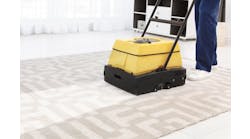Q: We are building a new elementary school and would like information on site development, including parking lots, driveways, nature trails, etc. — submitted by a school district in North Carolina
A: When designing school sites and facilities, administrators, teachers and parents have the opportunity to maximize the value of the entire school ground, and develop informal learning environments that complement classroom activities and engage students socially, physically and cognitively.
In designing a school site, a full range of settings should be considered — areas for active and passive recreation, outdoor gathering areas, mazes or games. Each element in the setting varies in importance based on a school's curriculum, community values, site constraints and location.
A school site must be thought of primarily as an outdoor informal learning environment — more than just a collection of play equipment or other functional elements such as parking or vehicular and pedestrian circulation.
This engagement starts at the site perimeter — those entering the grounds either can pass, disengaged, onto school grounds, or they can cross onto the site and feel a visceral connection to the site and its purpose.
A child's outdoor environment at school typically is turf and asphalt — a landscape designed for ease of maintenance and surveillance. A landscape designed for learning can be much more. This philosophy was echoed by a principal at a recently completed elementary school project: “Learning at our school is no longer constrained by four walls.”
Brain research indicates that interacting with the environment improves the structure, chemistry and function of the brain. A multi-sensory outdoor learning environment stimulates physical activity, problem solving, planning, and the processing of visual and auditory sensory input.
Good school site design draws on many disciplines — educational theory, cognitive development research, psychology, child welfare — in order to produce grounds that nurture a child.
School facilities also must be designed to engage and integrate all students by presenting enough variety to resonate with a range of individual expressions.
To understand a child's educational experience, we must focus on how the physical environment influences their time in the classroom.
The traditional approach to school site design typically has focused on low-budget elements with an emphasis on ease of maintenance, surveillance and safety. With a broader view of the site and engagement with the faculty, staff, students and community, schools can achieve a more inspiring vision while maintaining practical considerations.
The process starts with a commitment by school administrators to go beyond the simply functional and embrace the inspiring. This vision is best obtained by engaging designers, planners and architects with a broad understanding of educational dynamics such as child development and the teaching process.
Goltsman is co-founding principal with MIG, Inc., Berkeley, Calif.

